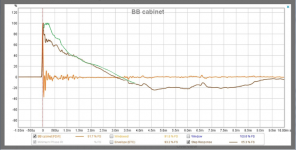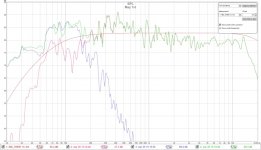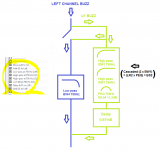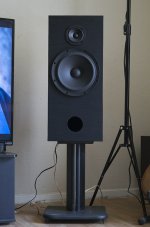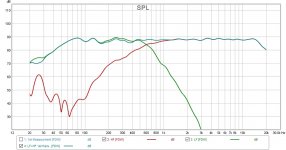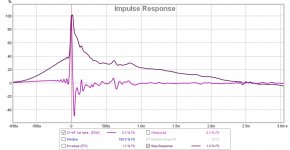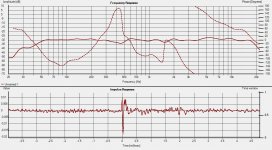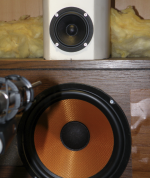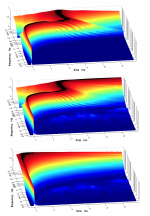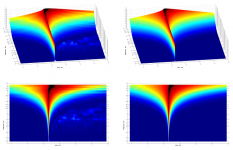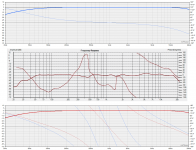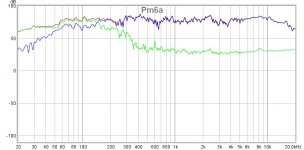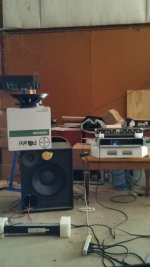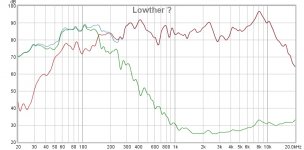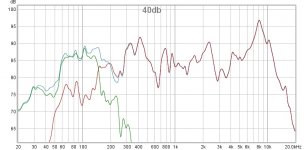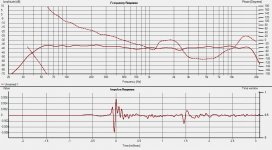Member
Joined 2009
Paid Member
A 4th order low pass on a woofer is not hard, as well as a 2nd order high pass on the full-range/tweeter. The trick is to use very nominally smooth-flat response drivers to start with and then use mechanical displacement to effect the large time-delay required for the Harsch XO. So for passice Harsch XO, you will end up with a big stepped baffle speaker (or perhaps a horn for the tweeter that gives it the required setback). Ideally, DSP is the most effective route. For passive, it might actually be easier to do a good first order, so-called, 'transient perfect' XO. I put that in quotes as Byrtt is very particular about the word perfect. Maybe 'transient good' is more accurate 
Indeed, I developed a passive Harsch XO for my PMC Clone TL speaker but I started with rather inexpensive drivers that were not very flat to start with and ended up requiring lots of filters (cost) to clean up. So start with a flat clean wide driver.
http://www.diyaudio.com/forums/mult...ed-tl-monitor-dc130a-dc28f-6.html#post4504336
Here is the Passive XO (I never built it due to cost/complexity):
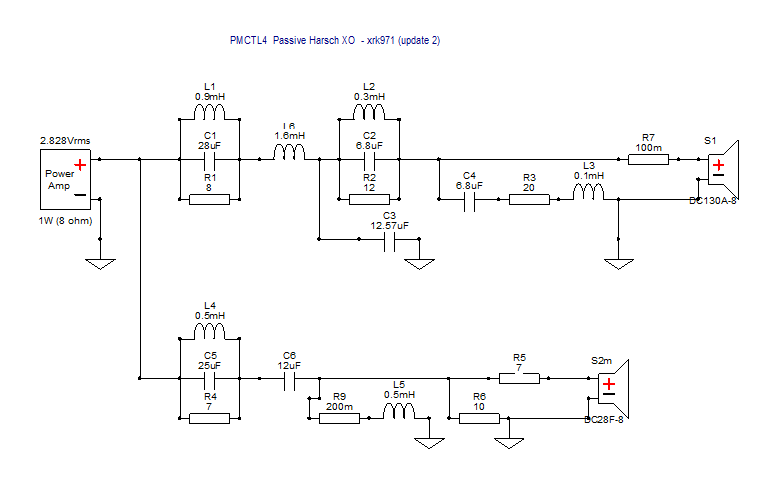
Predicted step response:
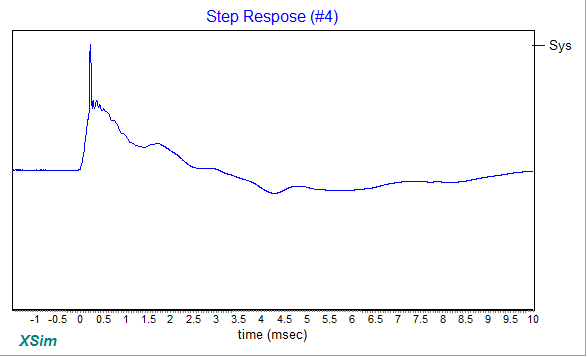
Speaker that the above passive XO was designed for. Now happily running Harsch on mini-DSP with active amplification:
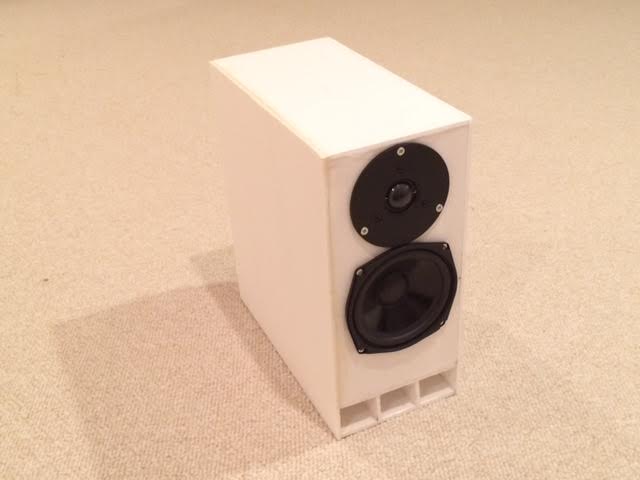
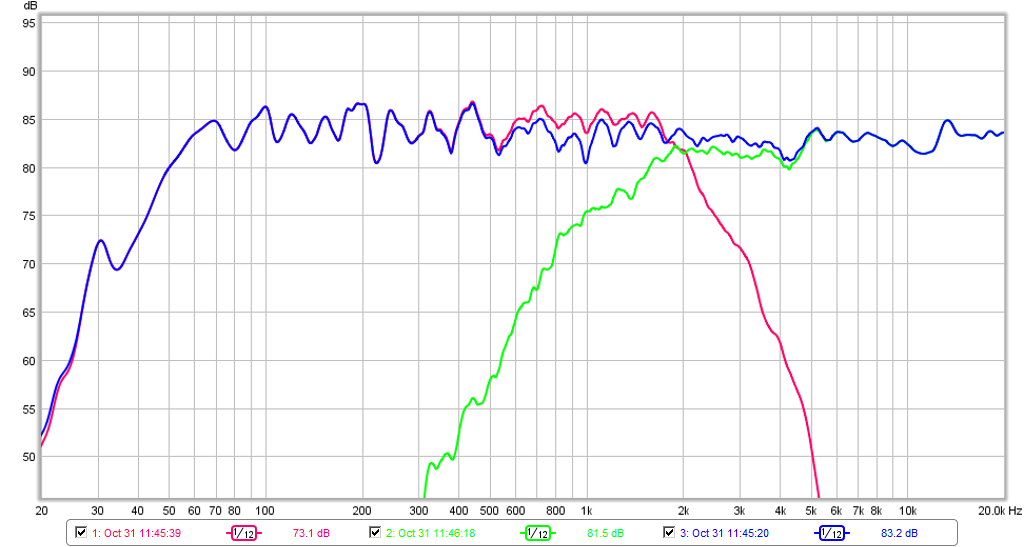
Indeed, I developed a passive Harsch XO for my PMC Clone TL speaker but I started with rather inexpensive drivers that were not very flat to start with and ended up requiring lots of filters (cost) to clean up. So start with a flat clean wide driver.
http://www.diyaudio.com/forums/mult...ed-tl-monitor-dc130a-dc28f-6.html#post4504336
Here is the Passive XO (I never built it due to cost/complexity):

Predicted step response:

Speaker that the above passive XO was designed for. Now happily running Harsch on mini-DSP with active amplification:


Last edited:
Oh my, Byrtt,
I know you meant well, but showing a window like this is going to scare away anyone not having great knowledge of DSP and its power. I'm not sure I understand it myself!
I, too, don't understand why some are so reluctant to add DSP to their chain... Pure sound doesn't mean just connect + and - to a driver to me. Pure sound should be the whole experience, without driver or box coloration, the best balance that brings a smile to my face.
I've never heard a driver that didn't need a nudge here or there to sound the best of its abilities.
...Ideally, DSP is the most effective route. For passive, it might actually be easier to do a good first order, so-called, 'transient perfect' XO. I put that in quotes as Byrtt is very particular about the word perfect. Maybe 'transient good' is more accurate...
See my name mentioned here
Easy example of the misunderstood non intended distortion is to look at your own simple passive 1st order implementation, below orange trace is your own measured step or square wave performance and green trace is my synthetic for how that declining curve as frq goes up response should have looked like, everything in square wave before 1,2mS is pure non intended distortion that in a proper executed 1st order system would not be there. If we seek stand out system sound yes its probably the way to go and can see with that nasty overshoot how its good to by ear judge and calibrate the right compensation cap as it was done over at ALPHA amp thread lately.
Its a bit over my head lately why it seems objective textbook target data seems had been dropped to get pleasing or stand out sound often mentioned as musicality/engagement/soundstage, aren't we just getting fooled in those subjective tests, what i mean here is after all we are listening to a recording so it got to somehow on a relative scale sound as a recording because microphone and various recording system devices have their natural limitations.
All that said suggest take a survive into a transient perfect isolated good acoustics headphone domain to discover how excess phase from higher orders than 1st order XO will sound like there, and think you will be surprised its so much more less a noticeable distortion than what one in real world acoustics environment will blame those XO's be responsible for and leading one to make wrong conclusions, on the contrary higher order help get drivers in their comfortable pass band zone normally leading to less distortion and also it helps one to hit exactly the target of what the XO topology dictates.
Attachments
Last edited:
...Oh my, Byrtt,
I know you meant well, but showing a window like this is going to scare away anyone not having great knowledge of DSP and its power. I'm not sure I understand it myself!
I, too, don't understand why some are so reluctant to add DSP to their chain... Pure sound doesn't mean just connect + and - to a driver to me. Pure sound should be the whole experience, without driver or box coloration, the best balance that brings a smile to my face.
I've never heard a driver that didn't need a nudge here or there to sound the best of its abilities.
Yes i meant it well and also think yourself understand it, doing below visual routing and filtering for a normal left and right channel will add excess phase distortion for a Harsch filter that then could be A/B evaluated into a head phone domain or via existing speakers.
Attachments
Last edited:
Harsch XO at 500Hz, FAST project inspired by X 10F/8424 & RS225-8 FAST Ref Monitor with SS 10F-8424G00 and SBA SB23NRXS45 powered by Alpha 20 for HF and FH9 for LF.
Thanks everybody for well documented process.
Cheers
A.
Thanks everybody for well documented process.
Cheers

A.
Attachments
if you have to choose
I decided to keep my big OB with no xo for AN 8" and build another project for Aino gradient clone 4way active dual 12" subwoofer sealed, baffless 12" PA woofer : 5" midrange (alpair 10p, someday i might try satori mr13p-8): tweeter with beston rt002a-dipole or vifa ox20sc00-04 like nao note
with only 1 minidsp 2x4hd and nu3000dsp for subwoofer, i have to choose 1 part which wont be handled by dsp but with simple crossover.
If you have to choose between woofer or tweeter (midrange is mandatory using dsp) for harsch XO without dsp, which one is the best try?
my first guess say that I can try passive harsch xo for tweeter, or pllxo before the amplifier then i can use physical delay which will be less than 5cm with 4.8kHz fc. 2nd guess is for the woofer and dont apply any delay since the cutoff is low and baffless already started to roll off in 200Hz
Thanks
I decided to keep my big OB with no xo for AN 8" and build another project for Aino gradient clone 4way active dual 12" subwoofer sealed, baffless 12" PA woofer : 5" midrange (alpair 10p, someday i might try satori mr13p-8): tweeter with beston rt002a-dipole or vifa ox20sc00-04 like nao note
with only 1 minidsp 2x4hd and nu3000dsp for subwoofer, i have to choose 1 part which wont be handled by dsp but with simple crossover.
If you have to choose between woofer or tweeter (midrange is mandatory using dsp) for harsch XO without dsp, which one is the best try?
my first guess say that I can try passive harsch xo for tweeter, or pllxo before the amplifier then i can use physical delay which will be less than 5cm with 4.8kHz fc. 2nd guess is for the woofer and dont apply any delay since the cutoff is low and baffless already started to roll off in 200Hz
Thanks
Three-way with 1x15", 1x6", 1.4" CD through baffle no horn.
Crossovers are LR48 600hz, LR24 600&1.5khz, LR48 1.5khz
While not as pretty as the shallower slopes, it's still much better than typical steep IIR implementations. Resolution is improved over the 24/12/24 setup I was using.
I would like to see if someone can get an even better phase linearity with steep slopes.
Crossovers are LR48 600hz, LR24 600&1.5khz, LR48 1.5khz
While not as pretty as the shallower slopes, it's still much better than typical steep IIR implementations. Resolution is improved over the 24/12/24 setup I was using.
I would like to see if someone can get an even better phase linearity with steep slopes.
Attachments
Three-way with 1x15", 1x6", 1.4" CD through baffle no horn.
Crossovers are LR48 600hz, LR24 600&1.5khz, LR48 1.5khz
While not as pretty as the shallower slopes, it's still much better than typical steep IIR implementations. Resolution is improved over the 24/12/24 setup I was using.
I would like to see if someone can get an even better phase linearity with steep slopes.
Cool. Got a picture of your setup?
Three-way with 1x15", 1x6", 1.4" CD through baffle no horn.
Crossovers are LR48 600hz, LR24 600&1.5khz, LR48 1.5khz
While not as pretty as the shallower slopes, it's still much better than typical steep IIR implementations. Resolution is improved over the 24/12/24 setup I was using...
Impressive system amplitude response there thanks, from own experience have comment when resolution is sensed improved then case is often that feature happens improve whenever acoustic centers is mismatched for one or another reason, and problem with that is often that system go musical material or genre dependant to have either over avarage improved resolution or less resolution than used to. LR filters if slopes and acoustic allignment is right will be in phase in XO region and unite a symetric forward pointing lobe or beam that is some directive (decreased power response in XO region) verse outside XO region because for traditional single drivers there is some distance from center to center, your system phase is generally looking flatter but counteracts for phase in XO regions so lobing and or tilted beam can happen at various vertical heights and think in general decreased power response distortion in XO region is probably same as for some pure LR filters. That said real world with minimum phase filters to sum more or less pass bands will cost some phase distortion relative to a clean theory textbook audio system pass band, first graph below show that theory textbook phase as musicians probably had under recording to synchronize their rhythm together either via head phones or because they physical situated together in one live take, second graph is your phase and third graph show phase turn for normal symetrical LR 4th and 8th order slopes at 500Hz and 1,5kHz inside system pass band.
Math behind distance step for real Harsch filter think is genius in it sum at least on paper with less overall phase and amplitude distortion compared to a theory textbook audio band.
...I would like to see if someone can get an even better phase linearity with steep slopes.
Ha ha you good, if time doesn't matter well we talk about mS seconds here to reverse and repair time domain then folks with FIR DSP engines can improve on that point.
Think not its easy task dial in XO but in 2017 did a two way'er with 16th (96dB/oct) order LR and FIR filters to repair the huge delay that happens at XO point, second attachment below show final result including FIR engine phase repair, the two at left is acoustic nearfield measurements and the two at right is corresponding theory textbook targets, in third attachment first graph is theory textbook target form for a 96dB/oct LR at 180 Hz, second graph is acoustic nearfield result after hundreds of minimum phase PEQs corrections and third graph is also acoustic and how it looks when a predicted 180Hz 96dB/oct LR time delay is reversed using FIR DSP engine. On a normal graph system phase after repair looks as in first graph in first attachment and forth attachment show used hardware experiment, by the way in that at 180Hz center to center distance is within 1/8 wavelenght and slope is so steep there is nealy no power response error inside XO region which seen in backlight is nice feature to experience about.
Attachments
Last edited:
Impressive system amplitude response there thanks, from own experience have comment when resolution is sensed improved then case is often that feature happens improve whenever acoustic centers is mismatched for one or another reason, and problem with that is often that system go musical material or genre dependant to have either over avarage improved resolution or less resolution than used to. LR filters if slopes and acoustic allignment is right will be in phase in XO region and unite a symetric forward pointing lobe or beam that is some directive (decreased power response in XO region) verse outside XO region because for traditional single drivers there is some distance from center to center, your system phase is generally looking flatter but counteracts for phase in XO regions so lobing and or tilted beam can happen at various vertical heights and think in general decreased power response distortion in XO region is probably same as for some pure LR filters. That said real world with minimum phase filters to sum more or less pass bands will cost some phase distortion relative to a clean theory textbook audio system pass band, first graph below show that theory textbook phase as musicians probably had under recording to synchronize their rhythm together either via head phones or because they physical situated together in one live take, second graph is your phase and third graph show phase turn for normal symetrical LR 4th and 8th order slopes at 500Hz and 1,5kHz inside system pass band.
Math behind distance step for real Harsch filter think is genius in it sum at least on paper with less overall phase and amplitude distortion compared to a theory textbook audio band.
There are some vertical irregularities but I still prefer that compromise over symmetrical LR filters. Especially noticeable at live playback levels. I've tried to dismiss phase response but I always come to same conclusions. Grow tired quickly of what I hear from typical implementations.
Ha ha you good, if time doesn't matter well we talk about mS seconds here to reverse and repair time domain then folks with FIR DSP engines can improve on that point.
Think not its easy task dial in XO but in 2017 did a two way'er with 16th (96dB/oct) order LR and FIR filters to repair the huge delay that happens at XO point, second attachment below show final result including FIR engine phase repair, the two at left is acoustic nearfield measurements and the two at right is corresponding theory textbook targets, in third attachment first graph is theory textbook target form for a 96dB/oct LR at 180 Hz, second graph is acoustic nearfield result after hundreds of minimum phase PEQs corrections and third graph is also acoustic and how it looks when a predicted 180Hz 96dB/oct LR time delay is reversed using FIR DSP engine. On a normal graph system phase after repair looks as in first graph in first attachment and forth attachment show used hardware experiment, by the way in that at 180Hz center to center distance is within 1/8 wavelenght and slope is so steep there is nealy no power response error inside XO region which seen in backlight is nice feature to experience about.
Very nice results. I always enjoy reading your analysis. I wouldn't be messing with Harsch if I had a decent FIR processor that didn't cost an arm and a leg for prosound use. I was planning on using an Open DRC but someone measured 15ms of delay before a filter was even loaded.
Final box will include two side mounted 15's, undecided mid-basses, 1.4" compression driver in front, 1" CD on each side. All in a box slightly larger than the one pictured powered by a QSC PLD4.5.
Attachments
what settings would show true responceAt that scale, anything will look kinda good... at first glance.

Attachments
Last edited:
Three-way with 1x15", 1x6", 1.4" CD through baffle no horn.
Crossovers are LR48 600hz, LR24 600&1.5khz, LR48 1.5khz
While not as pretty as the shallower slopes, it's still much better than typical steep IIR implementations. Resolution is improved over the 24/12/24 setup I was using.
I would like to see if someone can get an even better phase linearity with steep slopes.
Same thing except with Bessel filters. Seems that the important thing is that you have enough overlap to tie things together. The ultimate shape of the slopes don't seem to matter much. I think Danley and others have stated this a few times over the years. Pretty trivial to get excellent spatial, time, and frequency response with a decent coaxial and entry level dsp it seems.
Attachments
Last edited:
I'll give that a shot. thanks
That's quite the roller coaster ride.
- Home
- Loudspeakers
- Multi-Way
- S. Harsch XO
